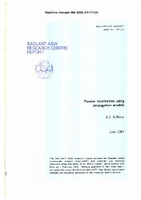| dc.contributor.author | Sullivan, Edward J. | |
| dc.date.accessioned | 2018-10-11T14:06:42Z | |
| dc.date.available | 2018-10-11T14:06:42Z | |
| dc.date.issued | 1987/06 | |
| dc.identifier | 1897 | |
| dc.identifier.govdoc | SR-117 | |
| dc.identifier.uri | http://hdl.handle.net/20.500.12489/285 | |
| dc.description.abstract | Passive ranging using propagation models can be effected in two different ways: forward modeling | |
| dc.description.abstract | and direct inversion. The forward-modeling method performs an exhaustive recomputation of the field | |
| dc.description.abstract | over a set of assumed source locations and seeks the best match to the measured data. The direct | |
| dc.description.abstract | inversion method inverts a set of linear equations constituted by the normal mode model. An overview | |
| dc.description.abstract | of these two approaches is given along with a summary of studies performed to date. This is followed | |
| dc.description.abstract | by the presentation of a maximum-likelihood algorithm for the direct inversion method. A discussion of | |
| dc.description.abstract | the merits and weaknesses of each method is given. Also, an appendix which discusses some general aspects of the inverse problem is included. | |
| dc.format | 14 p. | |
| dc.language | English | |
| dc.publisher | NATO. SACLANTCEN | |
| dc.relation.ispartofseries | ADA189404 | |
| dc.subject | Acoustic propagation | |
| dc.subject | Target localization | |
| dc.subject | Acoustic models | |
| dc.subject | Inverse problems | |
| dc.title | Passive localization using propagation models | |
| dc.type | Scientific Report (SR) | |
